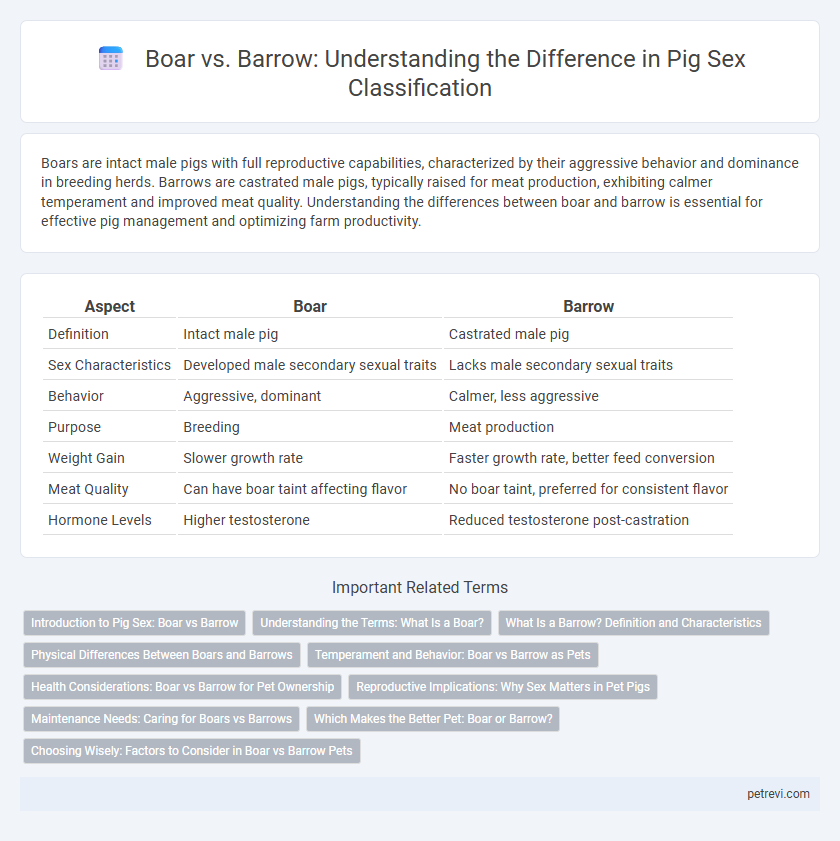Boars are intact male pigs with full reproductive capabilities, characterized by their aggressive behavior and dominance in breeding herds. Barrows are castrated male pigs, typically raised for meat production, exhibiting calmer temperament and improved meat quality. Understanding the differences between boar and barrow is essential for effective pig management and optimizing farm productivity.
Table of Comparison
| Aspect | Boar | Barrow |
|---|---|---|
| Definition | Intact male pig | Castrated male pig |
| Sex Characteristics | Developed male secondary sexual traits | Lacks male secondary sexual traits |
| Behavior | Aggressive, dominant | Calmer, less aggressive |
| Purpose | Breeding | Meat production |
| Weight Gain | Slower growth rate | Faster growth rate, better feed conversion |
| Meat Quality | Can have boar taint affecting flavor | No boar taint, preferred for consistent flavor |
| Hormone Levels | Higher testosterone | Reduced testosterone post-castration |
Introduction to Pig Sex: Boar vs Barrow
Boars are intact male pigs used primarily for breeding due to their natural reproductive capabilities, while barrows are castrated males raised mainly for meat production. The key difference lies in hormonal influence, where boars exhibit higher levels of testosterone affecting behavior and growth, and barrows tend to have more controlled temperaments and consistent weight gain. Understanding these distinctions is crucial for optimizing breeding strategies and meat quality in pig farming.
Understanding the Terms: What Is a Boar?
A boar is an intact male pig that has not been castrated, known for its aggressive behavior and used primarily for breeding purposes due to its strong genetic traits. Unlike a barrow, which is a castrated male pig raised mainly for meat production, a boar maintains its full reproductive capabilities and distinct hormonal characteristics. Recognizing the difference between a boar and a barrow is essential for managing pig breeding and livestock production effectively.
What Is a Barrow? Definition and Characteristics
A barrow is a castrated male pig, typically neutered before reaching sexual maturity to improve meat quality and manage behavior. Unlike a boar, which is an intact male pig capable of breeding, a barrow is raised primarily for pork production due to its more docile temperament and consistent growth rates. Characteristics of barrows include reduced aggression, less strong odor compared to boars, and a higher fat-to-muscle ratio, making them preferred in commercial pig farming.
Physical Differences Between Boars and Barrows
Boars are intact male pigs characterized by larger, more muscular bodies and prominent tusks, whereas barrows are castrated males with smaller, more rounded physiques and reduced aggressive behavior. Boars exhibit visible testicles and a coarser coat texture, while barrows lack these reproductive organs and typically have smoother skin. The physical differences impact their temperament and suitability for breeding versus meat production.
Temperament and Behavior: Boar vs Barrow as Pets
Boars tend to exhibit more aggressive and territorial behavior compared to barrows, making them less suitable as pets for inexperienced handlers. Barrows, being castrated males, generally display calmer temperaments and are easier to manage in domestic settings. Their reduced aggression and more predictable behavior often result in better integration with humans and other animals.
Health Considerations: Boar vs Barrow for Pet Ownership
Boars, being intact male pigs, have higher testosterone levels, which can lead to aggressive behavior and increased risk of boar taint, affecting both safety and odor in a home environment. Barrows, castrated males, typically exhibit calmer temperaments and reduced hormonal odors, making them more suitable for pet ownership and easier to manage health-wise. Regular veterinary care is essential for both, but barrows generally face fewer complications related to reproductive organs and hormonal imbalances.
Reproductive Implications: Why Sex Matters in Pet Pigs
Boars, intact male pigs, retain their reproductive capacity and exhibit natural mating behaviors, making them essential for breeding programs but challenging as pets due to aggression and odor. Barrows, castrated males, cannot reproduce, which reduces aggressive tendencies and eliminates the risk of unwanted litters, making them more suitable companions in a household setting. Understanding the reproductive implications of boar versus barrow status helps pet owners manage behavior, control breeding, and ensure responsible pig ownership.
Maintenance Needs: Caring for Boars vs Barrows
Boars require more intensive maintenance due to their aggressive behavior and stronger odor controlled by testosterone, necessitating secure housing and more frequent health monitoring. Barrows, being castrated males, exhibit calmer temperaments and reduced odor, making their daily care and handling easier and requiring less specialized infrastructure. Both need proper nutrition and regular veterinary care, but boars demand heightened vigilance for injury prevention and breeding management.
Which Makes the Better Pet: Boar or Barrow?
Boars, intact male pigs, exhibit strong territorial instincts and can be aggressive, making them less suitable as pets compared to barrows, which are castrated males typically calmer and more manageable. Barrows tend to have more docile temperaments, allowing for easier handling and interaction, important traits in a domestic setting. Understanding the behavioral differences between boars and barrows helps determine that barrows generally make better pets due to their reduced aggression and more sociable nature.
Choosing Wisely: Factors to Consider in Boar vs Barrow Pets
Choosing between a boar and a barrow as a pet involves assessing behavioral traits, as boars tend to exhibit more aggressive and territorial tendencies due to intact hormones, while barrows are generally calmer and easier to manage. Health considerations include the reduced risk of reproductive-related illnesses in barrows, which have been castrated, making them a more practical choice for long-term companionship. Owners should also evaluate space requirements and potential breeding risks, given that boars can impregnate females, potentially leading to unwanted litters.
Boar vs Barrow for Pig Sex Infographic

 petrevi.com
petrevi.com